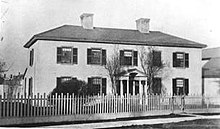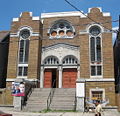Kensington Market
Kensington Market | |
|---|---|
Neighbourhood | |
 Shops in Kensington Market | |
 | |
| Country | |
| Province | |
| City | |
Kensington Market is a distinctive multicultural neighbourhood in downtown Toronto, Ontario. The Market is an older neighbourhood and one of the city's most well-known. In November 2006, it became a National Historic Site. Robert Fulford wrote in 1999 that "Kensington today is as much a legend as a district. The (partly) outdoor market has probably been photographed more often than any other site in Toronto."[1]
Its approximate borders are College St. on the north, Spadina Ave. on the east, Dundas St. W. to the south, and Bellevue Ave. to the west. Most of the neighbourhood's eclectic shops, cafes, and other attractions are located along Augusta Ave. and neighbouring Nassau St. and Kensington Ave. The market is best travelled on foot or bicycle, as the narrow one-way streets and numerous dead-ends are difficult to navigate by car.
History
Early history

George Taylor Denison, after serving in the British militia during the War of 1812, purchased an area of land in 1815 from Queen Street West to Bloor Street, roughly between where Augusta and Lippincott Streets now run. Denison used the area now known as Bellevue Square Park as a parade ground for his volunteer cavalry troop, which he commanded during the Upper Canada Rebellion. This troop later became the Governor General's Horse Guards. The Denison estate was subdivided in the 1850s. During the 1880s, houses were built on small plots for Irish and Scottish immigrant labourers coming to Toronto; many of these houses still stand along Wales Avenue and elsewhere, and these inexpensive homes have been inhabited by many waves of immigrants in the decades that followed.
The "Jewish market"

Kensington Market was slowly founded in the early twentieth century by eastern European Jewish immigrants and some Italians, who occupied "The Ward", an overcrowded immigrant-reception area between Yonge Street and University Avenue, in large numbers after around 1910. It became a cluster of densely packed houses, and was one of the poorer areas of the city. It became notable for the items and gifts, reminiscent of those in Europe, that covered the streets of the area. From the beginning, the market sold items imported from the homelands of the various immigrant communities.
Kensington was also known as "the Jewish Market". Jewish merchants operated small shops as tailors, furriers and bakers. Around 60,000 Jews lived in and around Kensington Market during the 1920s and 1930s, worshipping at over 30 local synagogues. After the Second World War, most of the Jewish population moved north to more prosperous neighbourhoods uptown or in the suburbs. During the 1950s, a large number of immigrants from the Azores, fleeing political conflict with the regime of António de Oliveira Salazar, moved into the area and further west along Dundas Street. The arrival of new waves of immigrants from the Caribbean and East Asia changed the community, making it even more diverse as the century wore on. The Vietnam War brought a number of American political refugees to the neighbourhood, adding a unique utopian flavour to local politics. As Chinatown is located just east of Kensington, the Chinese are now the largest ethnic element. During the 1980s and 1990s, identifiable groups of immigrants came from Somalia, Ethiopia, Sudan, Iran, Vietnam, and other global trouble spots.
The 1960s
In the 1960s there were plans to tear down the densely packed small houses and replace them with large, apartment-style housing projects, as was done to neighbouring Alexandra Park. These plans came to an end with the election of David Crombie as Mayor of Toronto. Crombie was strongly opposed to the massive urban restructuring plans that had been in vogue in previous decades.
Recent development
Today the neighbourhood is a noted tourist attraction, and a centre of Toronto's cultural life as artists and writers moved into the area. Land prices in the area have increased sharply, but despite its increased appeal to professionals, Kensington still remains a predominantly working class, immigrant community.
In November, 2006, Kensington Market was proclaimed a National Historic Site.[2]
The neighbourhood
Landmarks

Some area landmarks are the Number 10 Fire Station, Tom's Place, Bellevue Square Park with a statue of actor Al Waxman, and St. Stephen's Community House. Percy Faith, the 1950s composer and band leader, lived as a child at 171 Baldwin Street.[3] His uncle, Louis Roterbergh, a master violinist, taught him the violin, and was reputed to play at the house at Baldwin as crowds gathered below to listen.
Shops

The area is filled with a mix of food stores selling an immense variety of meats, fish and produce. There are also several bakeries, spice and dry goods stores, and cheese shops. Stores sell a wide variety of new and used clothing, and there are discount and surplus stores. It is also home to many restaurants covering a wide variety of styles and ethnicities. A unique architectural feature of the neighbourhood is the presence of extensions built onto the front of many buildings (which would be against by-laws in other places)[citation needed].
In recent years, the neighbourhood has seen a small explosion of upscale cafés, restaurants and clubs, replacing many of the older ethnic businesses. There has been much speculation that Kensington's long history as an immigrant working class neighbourhood is near its end.[4]
Counterculture
Businesses such as Manifestudio, a photo gallery and radical eco-politics community space run by GlobalAware Independent Media, help create an environment friendly to radical politics. Trotskyists are sometimes seen handing out pamphlets at the corner of Baldwin and Kensington. Over the past two decades, several radical bookstores have flourished in Kensington Market, including Who's Emma, the Anarchist Free Space, and Uprising Books.[citation needed]
One of Canada's most famous independent bookstores, This Ain't the Rosedale Library, also moved to Kensington from Church and Wellesley in 2008.
Commercial gentrification
A small supermarket, Zimmerman's Freshmart, opened in the Market in February 2005, leading to some controversy. Danny Zimmerman, the cousin of Freshmart's owner and the owner of a rival store across the street, expressed concern it would compete with smaller businesses, or would otherwise lead to a more "corporate" market. The arrival of COBS Bread in 2006 continues this potential trend. Also, some Market shops have started selling sweets and bread from Dufflet and Ace Bakery, two small Toronto-based independent bakeries. This has caused consternation amongst some traditionalists[who?].
Cars and pedestrians

Narrow streets make the market challenging for those driving and especially parking in the neighbourhood. On Saturdays and some late afternoons, pedestrians walk freely down the middle of the street or between slow-moving cars.
Since 2004, residents and businesses have organized a series of Pedestrian Sunday events. Parts of Augusta St., Baldwin St. and Kensington Ave. are closed to motorized traffic and the streets become a pedestrian mall. Live music, dancing, street theatre and games are among the special events on the closed streets. Typically taking place on the last Sunday of every month, this type of event has been organized on half a dozen weekends a year since 2005.
Culture
Festivals
This section needs additional citations for verification. (December 2008) |
The annual Kensington Market Festival of Lights[5] is celebrated on the streets of Kensington Market and at Bellevue Square Park during the Winter Solstice in December. This carnival parade of giant puppets, firebreathers, stiltwalkers and samba was first created by Ida Carnevali in 1987 as a way of beckoning the return of the sun on the longest night of the year — an ancient solstice tradition celebrated around the world. In 1995, after collaborating for three years Ida officially passed the torch to local artists and firebreathers Andy Moro and Gabriella Caruso, co-directors of community-arts organization Red Pepper Spectacle Arts. In 1987 the parade consisted of a handful of costumed revellers — it now welcomes over 10,000 people and continues to grow annually.
Parade goers of all ages make their own fantastic paper lanterns at Red Pepper's storefront studio in popular workshops during the month prior to the parade. All parade imagery is collaboratively created by community artists, local schools, community organizations and volunteers working with Red Pepper's creative team.
Other artists and groups like the Samba Squad,Shadowland Theatre, Clay & Paper Theatre, EagleHeart Drummers and Singers, Spirit Wind, Gaa Dibaatjimat Ngashi, Tumivut Youth Shelter, Maracatu Nunca Antes, Darbazi Choir, Circle-Sing, Richard Underhill and the Kensington Horns and many more have been long-time co-creators of this event.
The procession wends its way through Kensington's narrow streets witnessing surprise theatrical scenarios on rooftops and at intersections throughout Kensington Market. A giant fire sculpture marks the final send-off to the old year.
The Festival of Lights remains hand-made and commercial-free since 1987.
Kensington in popular culture and music
Former Toronto mayor Mel Lastman and actor Al Waxman (who starred in the CBC Television series King of Kensington) were both born and raised in the Kensington Market neighbourhood. After Waxman's death in 2001, he was honoured with a statue located in the north-west corner of Bellevue Square Park. In addition to King of Kensington, Kensington Market has been the setting for the television series Twitch City, which was filmed above the record store Paradise Bound, and Katts and Dog as well as the street riot scenes of the 1984 comedy Police Academy. Kensington Market was the primary setting for Cory Doctorow's novel Someone Comes to Town, Someone Leaves Town.
Kensington Market has been the home and founding location of many punk and metal bands, including Bunchofuckingoofs and Armed and Hammered. The Toronto based band Bedouin Soundclash filmed parts of their video When the Night Feels My Song in and around the market.
Kids' CBC, the daily children's programming block on CBC Television, includes some interstitial segments featuring Mamma Yamma, who owns a vegetable stand in Kensington Market.[6] Played by puppeteer Ali Eisner, Mamma Yamma teaches children about food-related subjects such as nutrition, table manners and basic mathematics, and also often incorporates celebrity and musical guests.
Religion
Two synagogues remain in the Market, from the early 20th-century period when the area was the centre of the Jewish community in Toronto.
Kensington Market is home to a significant Rastafari community.
-
Statue of Al Waxman in Bellevue Square Park
-
Bob Snider can often be found busking along Baldwin Street.
-
Minsk Congregation Synagogue (1930), Kensington Market, Toronto
Demographics
Census tract 0038.00 of the 2006 Canadian census covers Kensington Market. According to that census, the neighbourhood has 3,740 residents. Average income is $23,335, considerably below the Toronto average. The ten most common language spoken at home, after English, are:
- Cantonese - 14.3%
- Unspecified Chinese - 13.4%
- Mandarin - 9.4%
- Portuguese - 4.8%
- Vietnamese - 2.7%
- Spanish - 1.5%
- Korean - 0.7%
- Urdu - 0.3%
- Polish - 0.3%
- Serbian - 0.3%
Nearby streets of note
See also
- List of National Historic Sites
- List of neighbourhoods in Toronto
- No. 8 Hose Station
- St. Lawrence Market
References
- ^ "1999 real estate guide." Fulford, Robert. Toronto Life. Toronto: Mar 1999. Vol. 33, Iss. 3; pg. Insert
- ^ "New Designations Recognize the National Historic Significance of Canadian People, Places and Events". Parks Canada. 2006-11-30. Retrieved 2006-12-05.
- ^ 1911 Canadian Census
- ^ Louis Johnson: Market Forces: Commercial realtors hot for high rents see new Yorkville in funky Kensington. However, for now Kensington mostly retains its character as a great source for fresh foods, eclectic goods, and street food. Now Toronto, 10/14-21/08
- ^ Kensington Market Festival of Lights
- ^ Mamma Yamma at cbc.ca.


